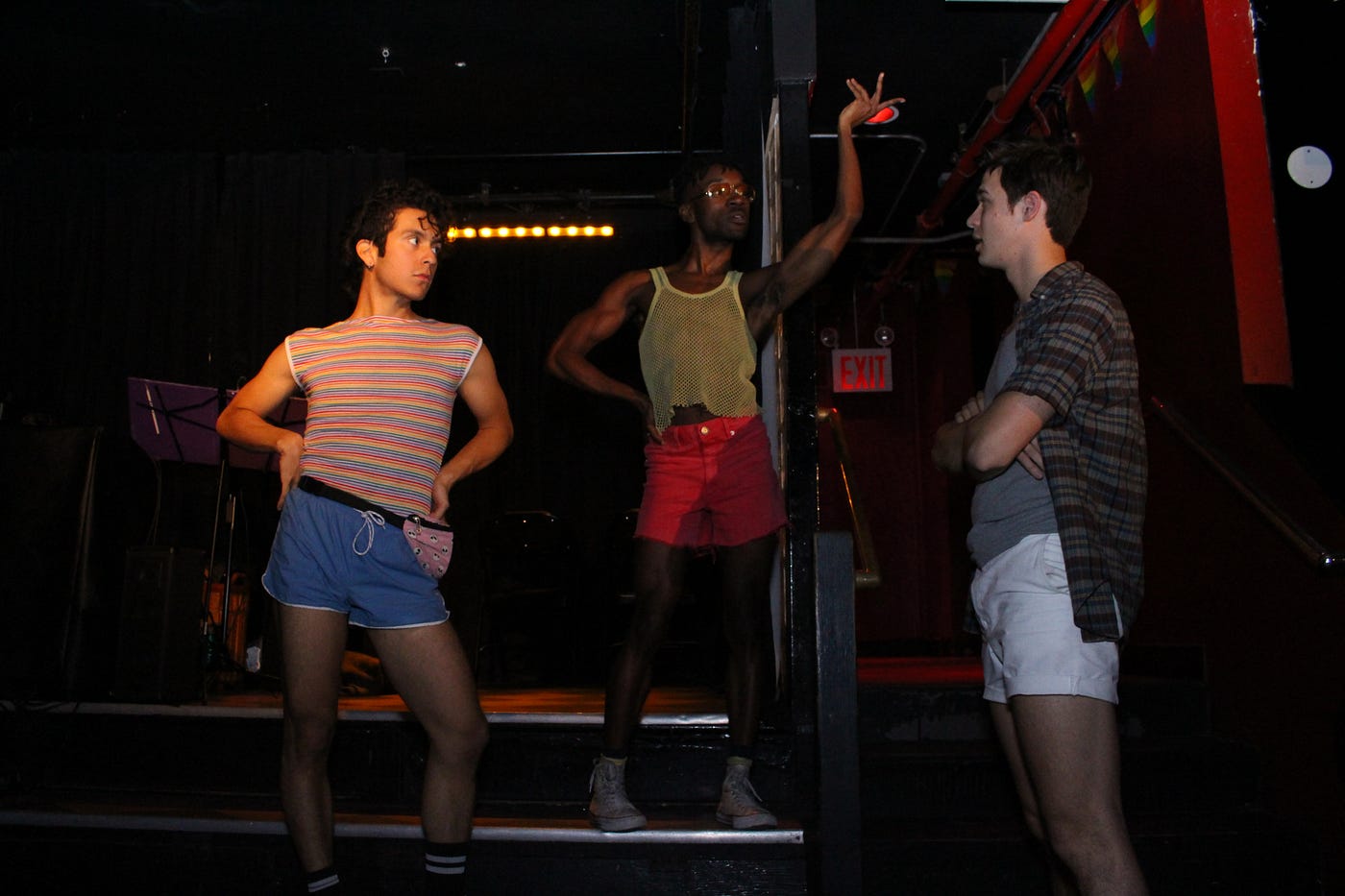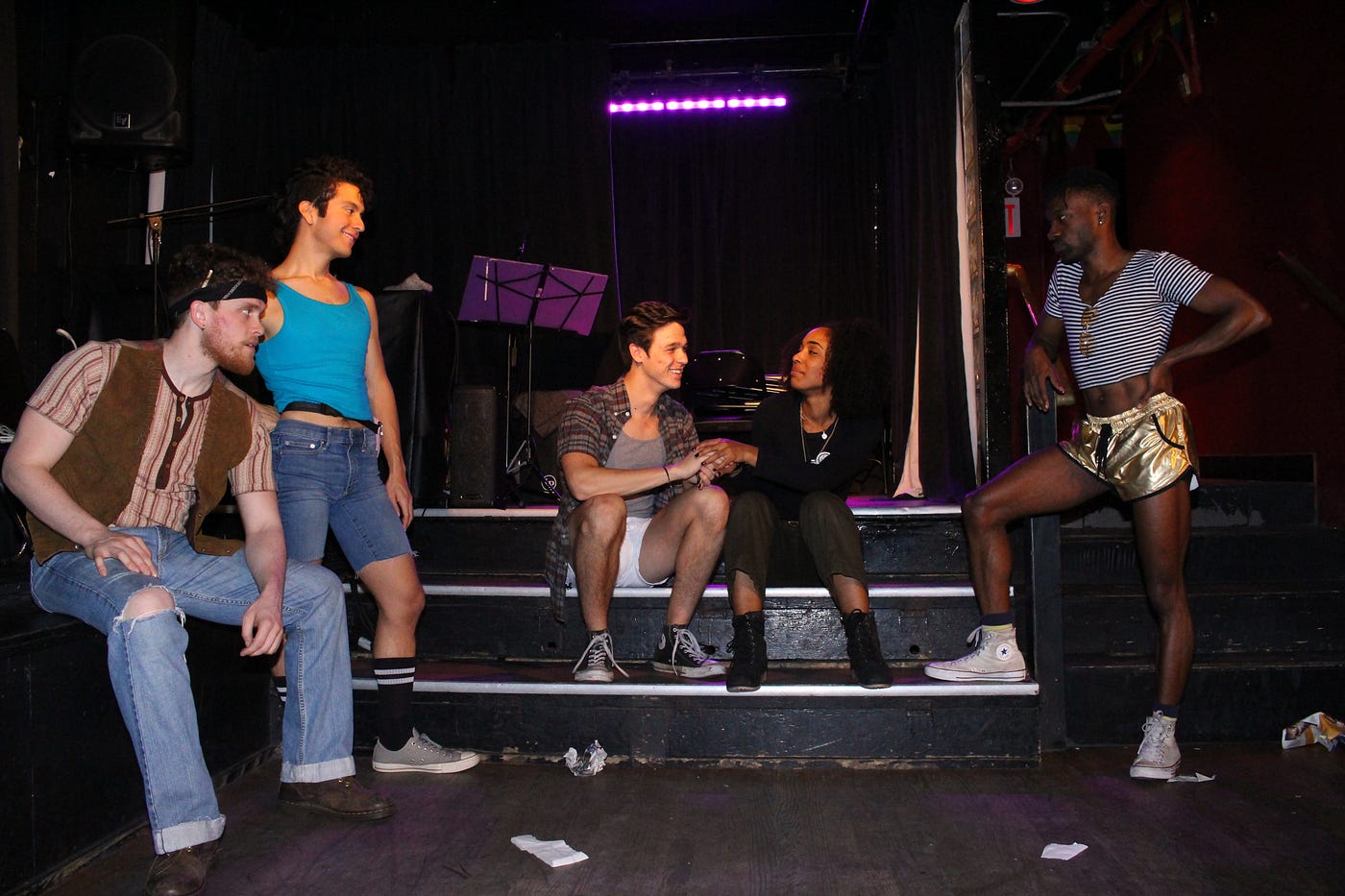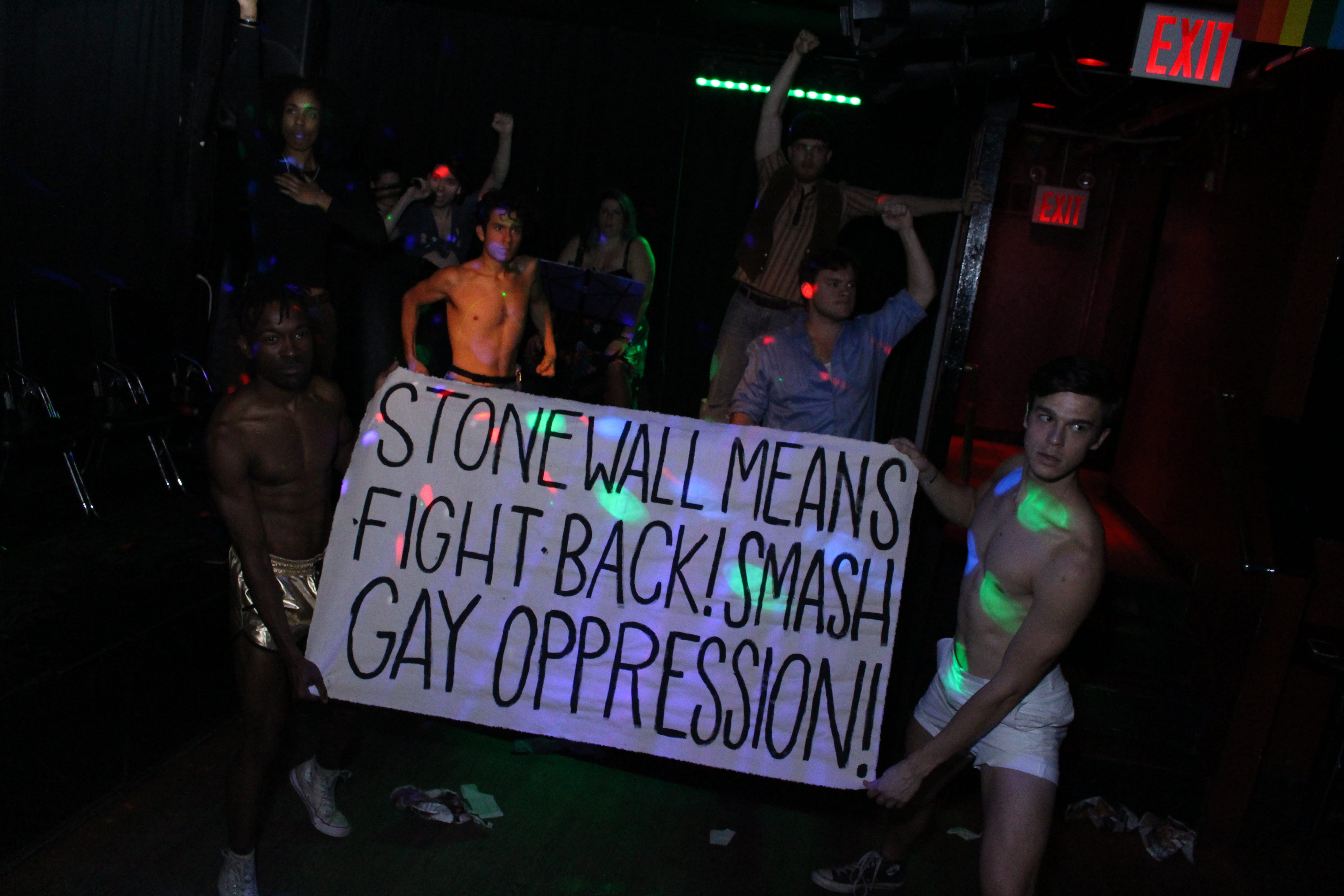A site-specific staging of Ike Holter’s play takes us back to where it began

Tucked in the back shadows of the first floor is a winding, narrow staircase that guides you to the second floor of the legendary Stonewall Inn. At the top of the stairs is a zigzag hallway. You can only imagine the intimate caresses and kisses shared here, as you maneuver through it, before spilling out into the upstairs bar and dance floor.
A few hours later, you witness a couple embraced in a drunken slow dance here. There are others partnered up and scattered on the dance floor. But this couple shares the spotlight with the band on… the “stage”? (It’s really closer to the size of a small platform.)
A band member (Andrew Swackhamer) is two degrees away from straddling his piano. He is seated on a stool but his position is severely cramped. There is hardly any space for him and the piano and the sound equipment on this hallowed, elevated ground — a platform that has been graced by icons in the drag scene. A singer (Kristen Dausch) wails and croons on the microphone alongside Swackhamer in perfect harmony and impressive vocal acrobatics. But the wild hot summer night of pulsing music, gyrating hips, flailing limbs, voguing arms, hoarse yelling, and guzzling alcohol is soon winding down.
Roberta, the leader of a women’s rights organization called W.I.L.D. (Women Internationally Learning Divisiveness), and her newest recruit, Peg, have just been engaged in a passionate makeout session a few moments before. Meanwhile the draft-dodging Cliff is keeping his broke fingers crossed that the drag-queen extraordinaire Carson will suggest a private place to go to. The wish to continue the night elsewhere hangs in the air for Tano as well, but he is alone. His fellow shot-taker and shade-throwing companion Mika is nowhere to be found. But if Tano catches Mika with that fresh-faced newbie, then it’s Oh, hell, no, girl — bye! The two had already spent time ridiculing the new gay from their favorite Greenwich Village stoop earlier that day. Shortly thereafter, Tano divulged his desperate desire to bait and hook the local “A-Gay”: someone that looks and acts completely straight with a probable career in finance or real-estate (usually white).

It sounds like any normal night at the Stonewall Inn, but a formidable shadow suddenly appears in the previously mentioned narrow hallway. One can clearly see an intimidating baton and a gun holster attached at the hip. The figure has close-cropped hair, broad shoulders, and a protruding belt imprisoning a tucked uniform shirt. It’s a policeman.
At first, his heavy footsteps disturb only a lull in the music, but when he brandishes his baton, the queer patrons struggle to shift from stupor to fearful alarm. He is barking orders, as spittle flies from his mouth like a dog in a violent rage.
At some point in the chaos of the night — I honestly can’t remember if it was during the clubbing section or after the policeman had entered — a few rows of seated audience members were asked to move. This section of chairs was dubbed “the immersive section”; these patrons moved from seats on the floor to seats pre-set along a skinny side that protruded out from the platform. The rest of the cast members formed a small formation by the band, while Peg and Carson were singled out by the policeman and thrown into a “cell” formed by the now empty chairs. It is no accident that these two are singled out: Peg is square, with no curves in her baggy jeans, wearing a white wife beater, while Carson’s black dress caresses every voluptuous shape padded on his tall, muscular frame. A single white spotlight bathes them in harsh fluorescent light and illuminates the stray hairs on Carson’s wig.
Get Michaela Ternasky-Holland’s stories in your inbox
Join Medium for free to get updates from this writer.
SubscribeSubscribe
What happens next is an educated guess of what led to the historic Stonewall Riots. The policeman beats, harasses, gropes, and shames Peg and Carson in a painfully paradoxical scene. Its extreme abuse is almost irreverent in the church of safety and acceptance for queer folk that Stonewall has now come to be, yet there is a holy silence as everyone watches, as this scene is nothing but brutal honesty and an unabashed look at the previously hate-ridden and abusive climate that these walls have witnessed.
Hit The Wall, written by Ike Holter, is an ensemble play with music that works painstakingly to reconstruct the people and events that led to Stonewall Riots.
This staging of Hit the Wall play takes place solely on the second floor of the Stonewall Inn. The first half of the plot focuses upon the characters coming in and out of the Christopher Park area. Like a game of hot potato, each character is introduced and deepened by a series of vignette moments that happen to cross one another. For example, after Tano and Mika scare off the newbie from their stoop in Greenwich Village, Carson walks by. Like bees to honey, Tano and Mika try to throw sass at Carson, but it all ends on a sour note with Carson stomping off to a funeral. Waiting for his time to see the now-dead Judy Garland, Carson is surprised to meet Cliff, who happened to have followed him from the park. The policeman is even introduced that afternoon as he shames Peg for her androgynous appearance and mocks her for begging Tano and Mika for a quarter. In horror, Peg disappears, but eventually is lured back into the park by the rousing shouts of Roberta advertising for W.I.L.D. Of course, all of the tangled connections eventually lead to everyone making plans at the Stonewall Inn that night.
The audience watches the narrative unfold in a seated “U” shaped position, whether from carefully placed sections of folding chairs or the comfy couches that are permanent fixtures in the upstairs layout of the Inn. The “stoop” is represented by the short stairs leading up to the platform where the band plays. Actors like the policeman also make dramatic entrances from the zigzag hallway. There are also moments where the space in front of the bar is used as either a bar or a meeting area. The use of the space gives the narrative a clear time and space for characters scenes to play out, both simultaneously and chronologically. The fight and club dance choreography has a precise chaos infused in it from the collective minds of Quinton Gutheir and Quincy Dow. There is a band, but outside of entry, intermission, and exit time, they play instrumental music throughout the majority of the piece, although some songs are used in high energy dance moments.
The piece has been previously staged in Chicago and Off-Broadway, but head-turning newcomers The Tribe have worked tirelessly for over a year to convince both the author for the rights to Hit the Wall and to convince the Stonewall Inn to house and stage the production’s run. For the audience, the piece had no exploratory or truly interactive moments, so if you are looking to take on a character or follow a reconstruction of the Stonewall Inn Riots, this is not your production. But this fact should not dampen the weight and epicness of Director Nick Brown’s genius.

Hit the Wall offers audiences a moment to witness a piece of well-written, well-researched work that mirrors the atmosphere and people present during the era of the Stonewall Inn Riots; the piece also offers world-class acting and musical talent. Both the cast and the band pull high energy from the snappy comebacks and snappy plot, but the true power of this staging is in Stonewall Inn’s impossible to replicate site-specificity, as the walls of the Stonewall Inn nearly vibrate while the performance is in motion.
As I left the Inn and glanced over to Christopher Park across the street, my chest buzzed with gratitude for the participants in the riots, but my limbs also felt euphoric. It truly was a chance of a lifetime to watch this renowned story unfold on the very grounds where the LGBTQ community was violated and abused, and yet where they also banded together and shook the world with their fed-up screams.
Hit the Wall has now concluded, but you can follow future productions from The Tribe on their site.
NoPro is a labor of love made possible by our generous Patreon backers. Join them today!
In addition to the No Proscenium web site, our podcast, and our newsletters, you can find NoPro on Twitter, Facebook, YouTube, Instagram, in the Facebook community Everything Immersive, and on our Slack forum.




















Discussion